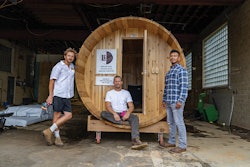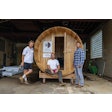
The sport of orienteering grew from its origins in military training, where soldiers learned to navigate across unknown territory with the aid of a detailed map, guided by a compass.
Orienteering is a lot like the job of construction superintendent on a pool project, which is to lead the team through all the unforeseen obstacles and traps that can be found on a jobsite and arrive at a safe, sound completion.
Fortunately, superintendents have those essential tools of orienteering, a compass and a map. The superintendent’s commitment to doing the job right despite the inevitable snags and tempting shortcuts is true North on the compass, and the map is the company’s procedural policy plan.
TAKE THE LEAD
In practical terms, the superintendent is responsible for leading the construction team to a successful outcome by following the company’s operating policy and procedure. He or she must assure product quality by holding the workforce to the company’s standard of performance.
At the same time, the superintendent is the essential link between the field to the home office, keeping them both on the same page and documenting progress.
As a superintendent working to make a difference, it will be your personal character which keeps you on the proper course to project completion. It is best that you and your construction team, whether they are fellow employees or subcontractors, come to understand a common idea of expectations and performance, as you’re stuck together in this situation, good, bad, or ugly. You must take the lead and guide them forward.
TWO BUILDERS, TWO SYSTEMS
Obviously, there are varied opinions on how best to perform swimming pool construction. During my 45 years in the aquatics industry, I have observed work performed in many different ways, the extremes of which are represented by:
Builder “A”
Builder A uses a defined well- planned system of oversight and quality assurance to achieve project completion accurately, timely, and with consistent results of performance.
Builder “B”
Builder B uses weak documentation, and depends on subcontractors to perform their work or fix anything incomplete or wrong as “they think best.” Builder B avoids the challenge of confronting problems, saying “the shotcrete guys will fix that... the tile man will fix that... the plaster crew will fix that...” etc., until there is no one left to pass the issue on to.
The latter process can be stopped if there is any oversight of the actual work being done (aside from driving by and receiving a wave from the foreman).
These projects struggle because several unrelated people (subcontractors) are determining how “they would do it if it were their pool,” and receiving no direction other than “just get it done.” No one is in charge, there’s no managed construction plan other than a phone list of subs, nor real understanding of what project completion really is. Such projects are regularly confronted with the question: What do we do next?
Upon completion, it’s no surprise to hear B’s client say:
“Well, it doesn’t look like we thought it would... I guess the builder had to make a change because...”
Construction managed this way will not only be frustrating and irresponsibly expensive to the business owner, but it places the company, subcontractors, and of course the client in circumstances which often lead to being compromised in product delivery or another swimming pool being left incomplete, or worse yet, another pool orphan for the local news.
The simple reason for constant crisis reaction in swimming pool construction is too many builders WISHING for positive outcomes, rather than WORKING for positive outcomes.
There is a better way forward.
YOU NEED IT IN WRITING
The first step to establish a viable connection between the field and home office is procedural policy. Procedural policy must always be in writing. If it is not in writing, there is no foundation to follow or train staff. In the absence of a written policy, DYSFUNCTION is the default for operations, which creates ever-changing, unaccountable and unpredictable outcomes. Operating policy and procedures define a clear path and specific details for the superintendent to move operations in the right direction.
A strong connection between the field and home office provides feedback and communication, ensuring compliance with the project requirements, and it documents the construction phase timeline. These reports provide evidence of all activities, and they allow the company management to evaluate performance, progress, monitor financial condition, and determine success or failure of the process.
IN THE FIELD
As the leader of the project, the superintendent sets the expectations and the pace for the work. This challenge requires superintendents to manage their time, behavior, and emotions, and work to achieve consistent results from their construction team. This task is vital to success.
Our pastor Joel Tietmeyer recently offered a lesson series which so perfectly summarized the rules of construction leadership that I have adapted his insights for the role of superintendent.
PRINCIPLE #1: BE THE MODEL
As the field supervisor, the model you live out determines the disciples or followers you will create. Like it or not, everybody is watching you! Your children at home, employees, the boss, and the client. The old saying, “Do as I say, not as I do,” will not work here! Therefore, be a role model which is accountable and approachable to all who observe you.
It takes personal commitment to make professional behavior a habit. It requires discipline to look at yourself and say:
- I am going to be what I want to see from others.
- I will take care of my own stuff, and stay in my lane.
- I recognize that snapping my fingers does not make something happen. I (or we) must grow through the process, which is an essential part of success, not a punishment.
To be approachable as a superintendent:
- Be genuine in your actions towards others, encouragement, and service.
- Be available to explain what someone is seeing on the job. Be open to answering questions, whether the situation is good or bad.
- Be honest, it makes you trustworthy!
PRINCIPLE #2: TIME, “I AIN’T GOT TIME FOR THAT”
We have all been guilty of this excuse! We seem to find something to fill our time during the workday, whether it is productive for us or not. As superintendent, you must ask, “Am I spending my time or investing it?” If you spend it, it is gone. If you invest in it, you get a return. Time is the great equalizer in our lives. We are all given 168 hours every week, 24 hours in each day, 60 minutes in every hour.
And those minutes matter. Most of us think in hourly blocks of time when it’s the minutes that really matter. When we start recognizing the value of minutes, we will begin to conquer the chaos.
I am a firm believer that if you do not manage your time well, you cannot manage your life or job effectively. When you realize that time is your most valuable resource, you will begin to make your calendar serve you rather than being a slave to your calendar.
OK, if time is our most important and severely limited resource, how do I become creative with it, maximize it, and trust my team to use it responsibly?
That’s where your head should be — focused on those questions.
PRINCIPLE #3: CONTINUITY AND CONSISTENCY
Superintendents lead through accountable modeling of what they want to see from others, especially consistency and continuity of action from team members.
What is consistency?
Consistency is doing something with regularity. Consistency automatically creates clarity and establishes a predictable value or defined expectation. Consistency may be about starting something new or simply attaching discipline to something you may already do.
Fill in the blanks: As I _____________, I will ________________.
- As I get to work, I will plan my time in minutes, not hours.
- As I meet a client, I will greet them appropriately, check their temperature and provide honest answers.
- As I encounter an unexpected challenge or confrontational problem, I will take 2 minutes and reset.
What is continuity?
Continuity is sustained effort to achieve a planned outcome. Where consistency creates clarity, continuity results in sustainability. How do you achieve continuity and consistency? Continuity and consistency are achieved by Super Humans instantly, but by the rest of us through continuous small steps and patience, i.e., training. Continuity and consistency are not gained by overachieving but by taking obvious actions.
Continuity and consistency of any policy or procedure is not accomplished by difficulty but through ease and adaptability for predictable, reliable acts, which results in the planned outcome.
PRINCIPLE #4: MOMENTS, WAIT A MINUTE!
You must learn to see and seize the limited opportunities you have to convey your expectation. By being accountable and approachable, the moments to teach or train will suddenly appear before you, especially when in the field. Grab them.
You can make plans for scheduled group training, but the best learning opportunities usually occur when you least expect them. You can increase these by building relationships with workers or peers and being approachable, as this encourages their engagement with you during the workday.
The rule of practice regarding these golden opportunities or moments is to be observant and say “wait a minute” when a good one is spotted; this stops the action and sets the stage for the short, concise message you want to convey. The best thing you can do is simply make yourself available and not miss these opportunities.
PRINCIPLE #5: MILESTONES — THEY ARE CONSTRUCTED AND CREATED.
Milestones — Where did we get the term milestone?
In ancient Rome, Emperor Augustus placed a gilded pillar at the center of the Forum in Rome. This marked the starting point for a system of roads, all of which led to Rome. The streets were marked every mile or “mille” — Latin for 1,000 — the distance a Roman Legion covered in 1,000 paces, with a stone “millarium” or milestone.
The milestones had several purposes. By them, travelers knew they were on a Roman road and had a standardized sense of the distance between two points, and these markers showed them where in their travels they were in relation to the Eternal City, Rome.
Milestones in construction serve as a check point along the plan. They provide reassurance so you do not stop believing in the progress you’ve made or the ultimate goal. If you lose that belief, you may start shirking issues that need immediate attention to achieve an orderly completion of the build, which is like everything in the future — a matter of faith.
PRINCIPLE #6: DECIDE NOW. STOP TRYING AND WISHING AND START TRAINING AND WORKING TO MAKE IT HAPPEN.
The difference between where you are currently and the success you are working for is a simple shift from Wishing to Working and Trying to Training.
The danger of wishing is that it never achieves consistent results. Wishing is an attempt to change with minimal commitment. Wishing is really like you’re planning to fail. Working is a wholehearted commitment to achieve a specific result. Working means training yourself to do what you can do today and strengthening yourself to do even more tomorrow. For you and your workforce to be effective, you need to change strategy: stop wishing and start working!
Training starts with the realization that I cannot achieve something without getting better, and it ends with actually doing it.
As you make the commitment, and as I close this article, remember the greatest deception is thinking that more information will lead you to a higher level. Actual change is harder than just understanding something, and requires transformation of behavior. Is now the time to stop wishing and start working to be the leader you could be?
Robert Baxter is a 45-year veteran of construction in the pool and spa industry and founding principal of Robax Development in Dallas. His construction supervisor course, "Construction Superintendent: Connecting the Field with the Home Office," is available through Genesis.
This article first appeared in the January 2025 issue of AQUA Magazine — the top resource for retailers, builders and service pros in the pool and spa industry. Subscriptions to the print magazine are free to all industry professionals. Click here to subscribe.











































